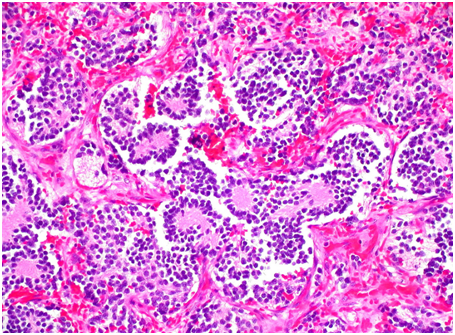13: Cancer Genetics
- Page ID
- 27321
\( \newcommand{\vecs}[1]{\overset { \scriptstyle \rightharpoonup} {\mathbf{#1}} } \)
\( \newcommand{\vecd}[1]{\overset{-\!-\!\rightharpoonup}{\vphantom{a}\smash {#1}}} \)
\( \newcommand{\dsum}{\displaystyle\sum\limits} \)
\( \newcommand{\dint}{\displaystyle\int\limits} \)
\( \newcommand{\dlim}{\displaystyle\lim\limits} \)
\( \newcommand{\id}{\mathrm{id}}\) \( \newcommand{\Span}{\mathrm{span}}\)
( \newcommand{\kernel}{\mathrm{null}\,}\) \( \newcommand{\range}{\mathrm{range}\,}\)
\( \newcommand{\RealPart}{\mathrm{Re}}\) \( \newcommand{\ImaginaryPart}{\mathrm{Im}}\)
\( \newcommand{\Argument}{\mathrm{Arg}}\) \( \newcommand{\norm}[1]{\| #1 \|}\)
\( \newcommand{\inner}[2]{\langle #1, #2 \rangle}\)
\( \newcommand{\Span}{\mathrm{span}}\)
\( \newcommand{\id}{\mathrm{id}}\)
\( \newcommand{\Span}{\mathrm{span}}\)
\( \newcommand{\kernel}{\mathrm{null}\,}\)
\( \newcommand{\range}{\mathrm{range}\,}\)
\( \newcommand{\RealPart}{\mathrm{Re}}\)
\( \newcommand{\ImaginaryPart}{\mathrm{Im}}\)
\( \newcommand{\Argument}{\mathrm{Arg}}\)
\( \newcommand{\norm}[1]{\| #1 \|}\)
\( \newcommand{\inner}[2]{\langle #1, #2 \rangle}\)
\( \newcommand{\Span}{\mathrm{span}}\) \( \newcommand{\AA}{\unicode[.8,0]{x212B}}\)
\( \newcommand{\vectorA}[1]{\vec{#1}} % arrow\)
\( \newcommand{\vectorAt}[1]{\vec{\text{#1}}} % arrow\)
\( \newcommand{\vectorB}[1]{\overset { \scriptstyle \rightharpoonup} {\mathbf{#1}} } \)
\( \newcommand{\vectorC}[1]{\textbf{#1}} \)
\( \newcommand{\vectorD}[1]{\overrightarrow{#1}} \)
\( \newcommand{\vectorDt}[1]{\overrightarrow{\text{#1}}} \)
\( \newcommand{\vectE}[1]{\overset{-\!-\!\rightharpoonup}{\vphantom{a}\smash{\mathbf {#1}}}} \)
\( \newcommand{\vecs}[1]{\overset { \scriptstyle \rightharpoonup} {\mathbf{#1}} } \)
\( \newcommand{\vecd}[1]{\overset{-\!-\!\rightharpoonup}{\vphantom{a}\smash {#1}}} \)
\(\newcommand{\avec}{\mathbf a}\) \(\newcommand{\bvec}{\mathbf b}\) \(\newcommand{\cvec}{\mathbf c}\) \(\newcommand{\dvec}{\mathbf d}\) \(\newcommand{\dtil}{\widetilde{\mathbf d}}\) \(\newcommand{\evec}{\mathbf e}\) \(\newcommand{\fvec}{\mathbf f}\) \(\newcommand{\nvec}{\mathbf n}\) \(\newcommand{\pvec}{\mathbf p}\) \(\newcommand{\qvec}{\mathbf q}\) \(\newcommand{\svec}{\mathbf s}\) \(\newcommand{\tvec}{\mathbf t}\) \(\newcommand{\uvec}{\mathbf u}\) \(\newcommand{\vvec}{\mathbf v}\) \(\newcommand{\wvec}{\mathbf w}\) \(\newcommand{\xvec}{\mathbf x}\) \(\newcommand{\yvec}{\mathbf y}\) \(\newcommand{\zvec}{\mathbf z}\) \(\newcommand{\rvec}{\mathbf r}\) \(\newcommand{\mvec}{\mathbf m}\) \(\newcommand{\zerovec}{\mathbf 0}\) \(\newcommand{\onevec}{\mathbf 1}\) \(\newcommand{\real}{\mathbb R}\) \(\newcommand{\twovec}[2]{\left[\begin{array}{r}#1 \\ #2 \end{array}\right]}\) \(\newcommand{\ctwovec}[2]{\left[\begin{array}{c}#1 \\ #2 \end{array}\right]}\) \(\newcommand{\threevec}[3]{\left[\begin{array}{r}#1 \\ #2 \\ #3 \end{array}\right]}\) \(\newcommand{\cthreevec}[3]{\left[\begin{array}{c}#1 \\ #2 \\ #3 \end{array}\right]}\) \(\newcommand{\fourvec}[4]{\left[\begin{array}{r}#1 \\ #2 \\ #3 \\ #4 \end{array}\right]}\) \(\newcommand{\cfourvec}[4]{\left[\begin{array}{c}#1 \\ #2 \\ #3 \\ #4 \end{array}\right]}\) \(\newcommand{\fivevec}[5]{\left[\begin{array}{r}#1 \\ #2 \\ #3 \\ #4 \\ #5 \\ \end{array}\right]}\) \(\newcommand{\cfivevec}[5]{\left[\begin{array}{c}#1 \\ #2 \\ #3 \\ #4 \\ #5 \\ \end{array}\right]}\) \(\newcommand{\mattwo}[4]{\left[\begin{array}{rr}#1 \amp #2 \\ #3 \amp #4 \\ \end{array}\right]}\) \(\newcommand{\laspan}[1]{\text{Span}\{#1\}}\) \(\newcommand{\bcal}{\cal B}\) \(\newcommand{\ccal}{\cal C}\) \(\newcommand{\scal}{\cal S}\) \(\newcommand{\wcal}{\cal W}\) \(\newcommand{\ecal}{\cal E}\) \(\newcommand{\coords}[2]{\left\{#1\right\}_{#2}}\) \(\newcommand{\gray}[1]{\color{gray}{#1}}\) \(\newcommand{\lgray}[1]{\color{lightgray}{#1}}\) \(\newcommand{\rank}{\operatorname{rank}}\) \(\newcommand{\row}{\text{Row}}\) \(\newcommand{\col}{\text{Col}}\) \(\renewcommand{\row}{\text{Row}}\) \(\newcommand{\nul}{\text{Nul}}\) \(\newcommand{\var}{\text{Var}}\) \(\newcommand{\corr}{\text{corr}}\) \(\newcommand{\len}[1]{\left|#1\right|}\) \(\newcommand{\bbar}{\overline{\bvec}}\) \(\newcommand{\bhat}{\widehat{\bvec}}\) \(\newcommand{\bperp}{\bvec^\perp}\) \(\newcommand{\xhat}{\widehat{\xvec}}\) \(\newcommand{\vhat}{\widehat{\vvec}}\) \(\newcommand{\uhat}{\widehat{\uvec}}\) \(\newcommand{\what}{\widehat{\wvec}}\) \(\newcommand{\Sighat}{\widehat{\Sigma}}\) \(\newcommand{\lt}{<}\) \(\newcommand{\gt}{>}\) \(\newcommand{\amp}{&}\) \(\definecolor{fillinmathshade}{gray}{0.9}\)Cancer is a group of diseases that exhibit uncontrolled growth, invasion of adjacent tissues, and sometimes metastasis (the movement of cancer cells through the blood or lymph). In cancer cells, the regulatory mechanisms that control cell division and limit abnormal growth have been disrupted, usually by the accumulation of several mutations. Cancer is therefore essentially a genetic disease. Although some cancer-‐related mutations may be heritable, most cancers are sporadic, meaning they arise from new mutations that occur in the individual who has the disease. In this chapter we will examine the connection between cancer and genes.

- 13.1: Classification of Cancers
- Cancers can be classified based on the tissues in which they originate. Sarcomas are cancers that originate in mesoderm tissues, such as bone or muscle, and cancers arising in glandular tissues (e.g. breast, prostate) are classified as adenocarcinomas. Carcinomas originate in epithelial cells (both inside the body and on its surface) and are the most common types of cancer (~85%)
- 13.2: Cancer Cell Biology
- This page explains that cancer starts with increased cell division, resulting in larger cells and a higher mitosis rate. As cancer advances, normal cell structure and organization are compromised, leading to dysplasia and tumor growth. Tumors can be benign or malignant, with malignant tumors being invasive and capable of metastasis. Early detection is vital for effective treatment to avoid the spread of cancer.
- 13.3: Hallmarks of Cancer
- This page outlines six hallmarks of cancer: growth signal autonomy, insensitivity to growth inhibitory signals, evasion of apoptosis, unlimited reproductive potential, sustained angiogenesis, invasion and metastasis, deregulated metabolism, immune evasion, chromosomal instability, and inflammation. These traits explain how cancer cells proliferate uncontrollably and evade normal biological processes that would typically suppress their growth.
- 13.4: Mutagens and Carcinogens
- This page discusses carcinogens, which are agents that increase cancer incidence, predominantly through mutagenic effects. It highlights HPV as a biological carcinogen linked to cervical cancer via oncogenes (E6, E7), and details ionizing radiation as a physical carcinogen damaging DNA. Additionally, it covers chemical carcinogens that require metabolism for effectiveness. Overall, reducing exposure to known carcinogens is emphasized as a method to lower cancer risk.
- 13.5: Oncogenes
- Genes that are a part of the normal regulation of cell division, but which after mutation contribute to cancer, are called proto-oncogenes. Once a proto-oncogene has been abnormally activated by mutation, it is called an oncogene. More than 100 genes have been defined as proto-oncogenes. These include genes at almost every step of the signaling pathways that normally induce cell to divide, including growth factors, receptors, signal transducers, and transcription factors.
- 13.6: Tumor Suppressor Genes
- This page discusses tumor suppressor genes, over 30 identified, crucial for DNA repair, apoptosis, and regulating cell division. Mutations, often loss-of-function, can be inherited or sporadic, with notable examples like BRCA1 linked to breast cancer and p53 associated with tumor development and early-onset cancer. The page emphasizes the significant role these genes play in cancer risk, with sporadic mutations often influenced by environmental factors like UV exposure.
- 13.7: The “Poster Boy” of Genetic Research Leading to a Cancer Treatment – Gleevec™ (Imatinib)
- This page discusses chronic myelogenous leukemia (CML), a blood cancer caused by the BCR-ABL chimeric protein leading to unchecked myeloid cell growth. The targeted therapy Gleevec™ (imatinib) inhibits this protein's kinase activity, effectively managing the disease but not curing it. Treatment challenges arise from patient variability and potential drug resistance, complicating effective management of CML.
Contributors
Dr. Todd Nickle and Isabelle Barrette-Ng (Mount Royal University) The content on this page is licensed under CC SA 3.0 licensing guidelines.


